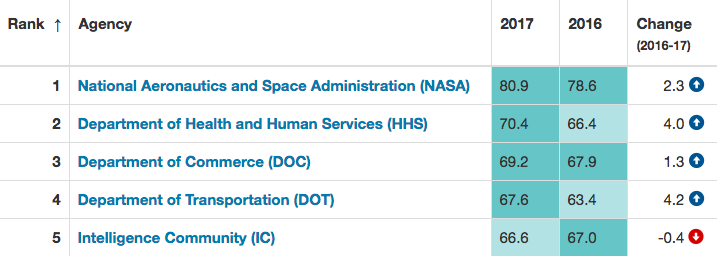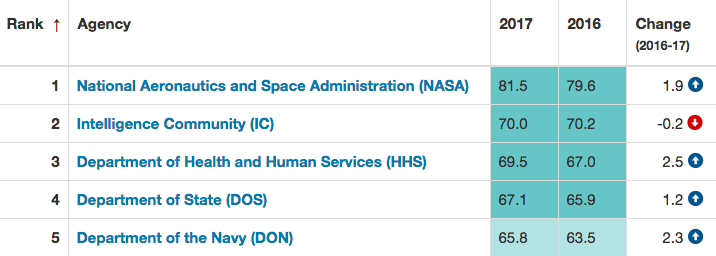What NASA Can Teach Agencies About Making Employees Happy

IO manager Luis Morales monitors the status of NASA's Cassini spacecraft in mission control at NASA's Jet Propulsion Laboratory, Friday, Sept. 15, 2017, in Pasadena, Calif. Jae C. Hong/AP
The government’s most innovative agency increased employee satisfaction for the sixth year in a row.
NASA once again boasts the highest employee satisfaction scores of any federal agency and remains the most innovative place in government, according to an annual survey of the best places to work in government.
As NASA’s ratings increase for the sixth year in a row, the agency shows that investing in employee engagement may help address the growing talent gap in government technology.
NASA scored well above every other large federal agency in employee satisfaction—which factor in workers’ opinions on leadership, pay, work-life balance and strategic management. The agency also topped the private sector average by more than 3 points.

Employees also rated NASA as the large agency where innovation and creativity are most rewarded. The Partnership for Public Service and Deloitte innovation rankings were derived from responses to the Office of Personnel Management’s annual Federal Employee Viewpoint Survey, which also included questions about whether employees feel motivated and encouraged to come up with new and better ways of doing things.

The Federal Trade Commission was rated the most innovative mid-size agency with a score of 76.9, and the Office of Management and Budget topped the list of the most innovative small agencies with a score of 78.0.
What stands out most about NASA’s success is that the agency increased its 2017 numbers despite leading large agencies in employee satisfaction by more than 12 points last year, said Sean Morris, who leads a federal human capital team at Deloitte. Instead of “resting on their laurels,” the agency continued to invest in employee engagement, he said.
“They absolutely see the correlation between higher levels of employee engagement [and] increased performance,” Morris told Nextgov. This has helped NASA maintain its place as “the center of the universe for rocket scientists” even as private companies have started vying to make it to space.
NASA’s constant efforts to improve shows employees their voices are being heard, Morris said, which is becoming increasingly crucial to attracting younger, more data-savvy applicants to the agency. And it’s time other federal agencies begin to take notice, he said.
“The processes, procedures and technologies that are in place today don’t lend themselves to being able to bring people in,” he said. “If you look at the demographics of the federal government, it speaks to this problem in spades.”
In the federal IT workforce, the number of employees age 60 or older is more than quadruple the number of specialists under the age of 30 as of September 2017. Without the right talent in government tech, agencies’ ability to serve and defend the American people is stunted, according to Morris.
And increasing employees satisfaction may be possible even as agencies see their funds dwindling. Little things like telework and self-service systems to update personal information could have a significant impact, he said.
“It doesn’t always cost money to increase employee engagement,” Morris said. “It’s really thinking about experience of the employee from a human-centered perspective. It shows your employees that you’re listening to them and you’re trying to change the way they’re interacting with their organization.”



